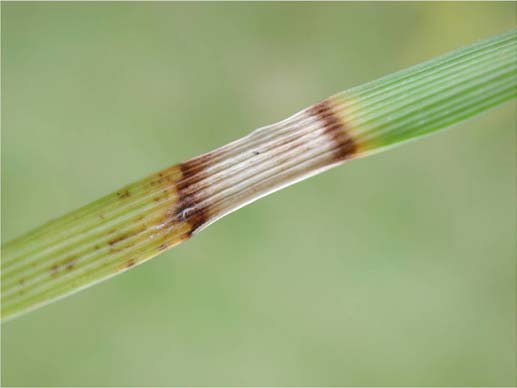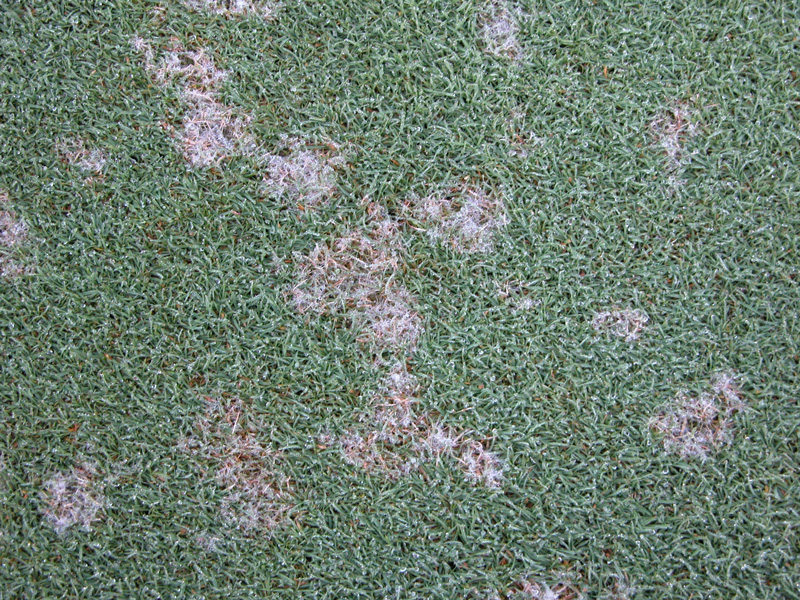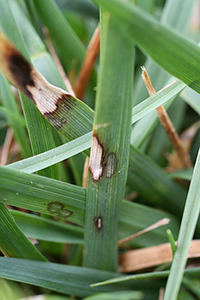Dollar Spot
The turf community of old wasn’t exactly the most creative when it came to naming various diseases that affect turf. Case in point is the most easily identifiable and, arguably, most prolific disease…dollar spot. It was given its name because the in the early stages of the outbreak, each “spot” of the infection is about the size of a silver dollar. While not overly creative, the description is very fitting.

Dollar spot is caused by a fungal pathogen, Sclerotinia homoeocarpa, which scars the leaf blades without killing the root or crown of the plant. The disease is a very common concern on golf course turf, especially creeping bentgrass and annual bluegrass greens, tees, and fairways, where it can cause serious damage to playing surfaces. Dollar spot may occur in home lawns and can reduce the lawn’s aesthetic quality and contribute to an overall decline in turf vigor.
Symptoms
On putting greens, dollar spot appears as small, “dollar sized”, that are bleached-white or light tan in color. On turf mowed at heights greater than 0.5”, the spots may expand in size up to 6” or more in diameter. The infected leaf blades typically remain upright and are generally characterized by having white or light-tan lesions with light reddish-brown margins. As the lesions expand, the leaves are girdled and the upper part of the leaves dies slowly. Distinct lesions are sometimes not evident on close-cut turf; instead, the leaf blades die back from the tip and turn white or light tan in color. The grass in the spots may be killed to the soil surface if the disease continues to develop and many spots may merge to produce larger affected areas. Short, fuzzy white mycelium is often observed on affected turf in the morning when dew is present.
Causes

The dollar spot pathogen survives in the turf environment as mycelium in infested debris such as thatch. The fungus becomes active with rising temperatures in the spring. Mycelia growth and infection occur during extended dew periods (longer than 8 hours) over a broad range of temperatures (55˚-80˚F). Heavy dews that often form during cool nights in the late spring or early summer are most conducive to the disease. Extended periods of wet, overcast weather can also lead to severe dollar spot outbreaks on susceptible grasses. The dollar spot fungus produces no spores; but rather spreads from plant to plant by the movement of the leaf blades, most typically with mowing. Dollar spot remains active throughout the summer in many areas, but disease activity typically slows when high temperatures consistently exceed 90°F.
Turf that is deficient in nutrients, especially nitrogen, is more prone to dollar spot and also recovers from the damage more slowly than well-fertilized turf. On golf course fairways and putting greens, dollar spot severity is increased significantly in nitrogen-deficient turf. On residential turf, dollar spot usually accompanies the normal depletion of nitrogen nutrition in late spring or early summer. The disease is also encouraged by drought stress, low mowing, excessive thatch accumulation, frequent irrigation and low air movement. Certain cultivars of creeping bentgrass, perennial ryegrass and Kentucky bluegrass are very susceptible to dollar spot, while others are fairly tolerant
Prevention and Treatment
There are a number of practical recommendations that will significantly reduce the likelihood of a dollar spot outbreak.

Because dollar spot is more severe on nitrogen-deficient turf, an adequate nitrogen fertility program will delay disease outbreaks in spring, reduce outbreak severity, improve fungicide performance and speed up recovery time. Select nitrogen sources, rates and timings based on local University recommendations for your turfgrass species and climate. In residential turf, dollar spot will generally be suppressed with supplemental fertilizer applications of .2 pounds of nitrogen per 1,000 square feet in midsummer. Deficiencies in other nutrients that limit foliar growth may also exacerbate dollar spot problems. It’s highly recommended to use soil test results to apply the recommended amounts of phosphorus, potassium, lime and micronutrients that are needed.
Dollar spot is encouraged by drought stress and leaf wetness. Proper irrigation timing is needed to balance these factors. Irrigate based on the moisture status of the soil, not on a calendar schedule. When irrigation is necessary, it should be applied early in the morning, between midnight and 6 AM, to keep leaf wetness periods as short as possible. Mowing, dragging, or whipping the turf in the morning to remove dew can help to prevent dollar spot, but these practices can spread the disease if it is actively developing.
Excessive thatch accumulations greatly encourage dollar spot activity. Remove excess thatch by vertical mowing or power raking. Golf course putting greens should be aerified regularly and topdressed with sand to reduce thatch buildup. Dollar spot is readily spread in leaf tissue or clippings from infected areas. Avoid spreading the disease by washing equipment before entering an uninfected area and by removing and disposing of clippings taken from infected areas.
Fungicides
Many fungicides control dollar spot, but preventative applications are most effective. Most contact fungicides usually require applications every 7-14 days, while system fungicides only require applications every 21-28 days. A preventative program should be implemented in the early spring when night temperatures consistently exceed 50°F. When applied on a curative basis, fungicides must be applied at high rates and short application intervals. These fungicides should be applied in no less than 2 gallons of water per 1,000 square feet. It’s important to note that the fungus that causes dollar spot develops resistance to fungicides very quickly. Fungicide application is rarely necessary for dollar spot control in residential lawns.
The products we recommend for controlling gray leaf spot are:
Lebanon Eagle .62G Fungicide - For general turf use
Lebanon Daconil 5% Fungicide - Not for use on residential turf or home lawns